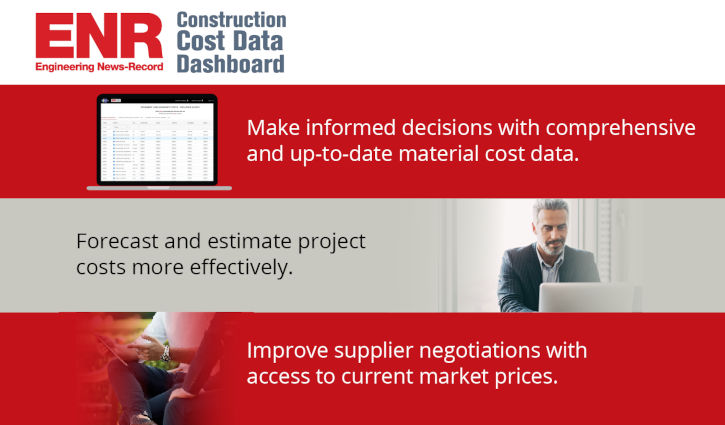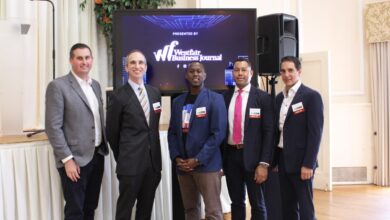ENR 2024 Top 500 Design Firms: Artificial Intelligence Ramps Up
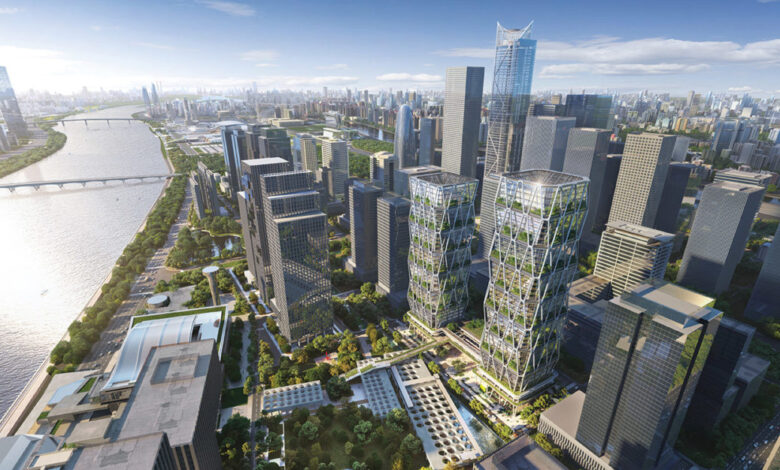
✕
Commentary from the Top 500 Design Firms in 2024 reveals a shift in the use of artificial intelligence to complement design services. Last year, AI was the exception more than the rule, but this year more design professionals aim to integrate tech into operations. With ongoing labor challenges, rising interest rates and supply chain disruptions still driving up construction costs, firms say AI could be the X factor that helps projects stay profitable.
From 2022 to 2023, global Top 500 design revenue rose 12.5% to $137.8 billion, with domestic revenue up 12.7%, to $116.9 billion, and international revenue rising 11.7% to $21 billion. Since pre-pandemic 2020, overall revenue for Top 500 firms has increased 33.5%—reflecting a growing demand for design services that underscores the industry’s pressing labor recruitment and retention challenges.
“This includes engineers, surveyors, landscape architects and planners,” says Brent Mutti, firmwide production manager at Kimley-Horn, which is ranked No. 10 on the Top 500 list.
“Compounding this issue is the declining graduation rates for STEM majors, which points to a long-term trend that is likely to only get more challenging,” from design to the construction trades, he says.
A Tumultuous Talent Market
In its first quarter 2024 Engineering Business Sentiment Study released in February, the American Council of Engineering Companies (ACEC) found that 51% of 571 firms surveyed turned down work in the past three months “due to workforce shortages.”
Of those, 88% reported that they are “being more selective about the projects they are accepting” because of workforce shortages, up 8% from the survey released last year.
For many firms, being selective about projects comes down to numbers, says DCCM Chairman and CEO James F. Thompson. The Houston-based firm is ranked No. 130.
“In simple terms, we do not have the raw numbers of adequate engineering talent in our various marketplaces to meet our needs,” he says, adding that the firm plans to change “what is commonly deemed the acceptable compensation structure for all levels of staff” to offset a change in project capacity. As a result, Thompson anticipates a “needed change in the costing of our projects, and I see this as the most critical challenge facing our industry,” he says.
DCCM’s cost restructuring plans are consistent with the ACEC report, which found that “wage inflation is the biggest single concern among firm executives” entering the 2024 construction season. Political disruption from the upcoming presidential election was second.
While the workforce need can be daunting to firms, “it is a great problem to have,” says Bartlett & West CEO Joe Caldwell, “but a huge challenge regardless.” Ranked No. 258, the firm added nearly 100 employee-owners to its head count last year, and the firm continues to see its backlog grow, he adds. According to Caldwell, this has allowed Bartlett & West to be “more selective and pursue projects that set us and our clients up for long-term success.”
Behind the Numbers
Revenue gains for this year’s Top 500 firms are evenly distributed among list participants. Of the 479 firms who filed this year and last, 84.6% increased their revenue. Median firm revenue rose 11.3%, from $79.7 million last year to $88.7 million this year, up 30.6% from pre-pandemic 2020.
Although most sectors have recovered from pandemic challenges, supply chain disruptions linked to global political and climate crises are once again driving up materials costs, explains Anirban Basu, chairman and CEO of Sage Policy Group and a construction sector economist. “We are starting to see some pressures on shipping costs,” he says, also noting price increases in some materials. Megaprojects are resource-intensive initiatives “that are just soaking up so much of the construction material that [it] drives up the price for everybody,” he adds.
Adding to increased costs are higher loan interest rates set by the Federal Reserve to curtail inflation, which “put the industry on hold essentially,” says Humphreys and Partners Chief Innovation Officer Walter Hughes. “Current economic conditions tightened lending conditions and fairly high construction costs have hindered new developments.”
Keeping firm operations flexible has enabled BWBR to better help clients navigate economic uncertainty, said President and CEO Terri Ulrick.
“Employee expectations have changed dramatically in the past few years, from demands for greater equity to changing requirements for work-life balance,” says Ulrick. “While I believe BWBR’s renovated offices and commitment to flexible, hybrid work have positioned us well, we must also help our clients meet these challenges and evolve their own thinking in order to create spaces that support and inspire success.”
Missing Skills
As Top 500 designers look to fill open positions, many firm representatives say they have implemented internship and professional development programs to help bridge the knowledge gaps between retiring longtime workers and less experienced new hires.
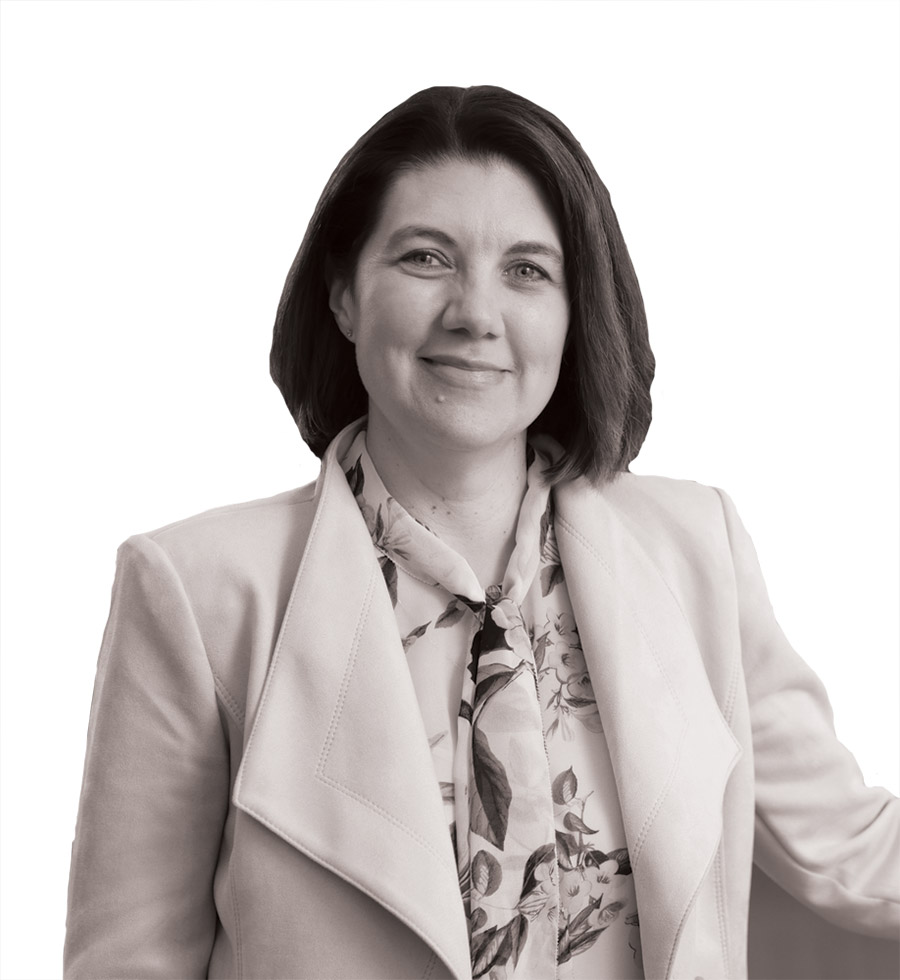
“Employee expectations have changed dramatically in the past few years, from demands for greater equity to changing work-life balance.”
Terri Ulrick, President and CEO, BWBR
“There is a notable gap between Baby Boomers who are exiting the industry via retirement and Millennials who are in the market but without the level of experience that is leaving,” explains Mitch Smith, chairman and CEO of MG2, which ranks at No. 240. He says the firm is bridging the skills gap by “partnering team members” who are less experienced with those who are more experienced.
“Architecture is a knowledge and expertise-driven profession,” adds Smith. “The complexity of the industry is accelerating tremendously on all fronts. It has been exceedingly difficult for the depth of knowledge in talent to stay on pace with the changes in the industry.”
A shortage of talent hampers the AEC sector’s ability to grow and excel—spurring more companies to invest in ways to retain employees for the longer term.
“Architecture and engineering students usually don’t receive any sort of formal business instruction as part of their education,” says Richard W. Humann, president and CEO of H2M architects + engineers. Ranked No. 220, the Melville, N.Y.-based firm’s in-house Learning + Development Academy provides entry-level and leadership-level employees with learning opportunities in public speaking, project management and more.
“We prefer to give our employees the skills they need to advance into leadership roles here at H2M rather than hire someone from outside the organization to run things,” he says.
No. 338-ranked design firm Plummer makes similar investments to develop employee core skills for career advancement. “Leadership, communications and emotional intelligence are sometimes missing in our available labor market,” says CEO Chris Young. “I believe these skillsets can be grown and developed.”
Professional Development
GHD uses an internal professional development strategy that focuses on “upskilling” employees through dynamic learning and experiences.
“This approach also allows us to maximize the diversity of our people and capture non-traditional expertise that can be redeployed or quickly upskilled to address talent shifts and shortages,” says Jan Sipsma, its chief people officer. “We have been on a journey over the past year to activate three key approaches that are critical to addressing the evolving nature of the labor market: a skills-based organization, workflow-centered learning and learning partnerships.”
Balancing project and owner demands and navigating the labor market adds another level of complexity to managing talent resources—including securing those who are specialized in the areas of sustainability and health care, says Fiona Cousins, Arup’s Americas Chair.
“Finding experienced professionals who excel in leadership and possess specialized knowledge is critical to our mission of shaping a more sustainable world,” she adds. “We’ve established structured professional development programs to guide talent from entry-level roles such as graduates to seasoned experts, fostering growth within our organization.”
Arup is “grappling with the multifaceted challenge of aligning our projects with the pressing global issues of climate change, social equity and biodiversity loss,” Cousins says. “This challenge is emblematic of broader trends in the AEC industry, where the impact of our decisions extends far beyond the immediacy of the built environment.”
Mixed Use | By Jonathan Keller

Rendering courtesy of AO
AO (No. 210) is architect for the Boardwalk at Bricktown, a proposed 2.7-million-sq-ft mixed-use development in Oklahoma City. Designed to be the tallest structure in the U.S. at 1,907-ft, its developer, Matteson Capital, has secured financing. The project has been approved by the city planning commission but awaits approval by the city council. The full structure will include a 480-key hotel and 110,000 sq ft for retail, dining and entertainment.
AI as the ‘X Factor’
Along with their investments in developing traditional employee skills, many Top 500 firms also say they are testing out artificial intelligence-powered technology to complement their design operations with hopes of giving their companies a competitive edge.
“We see a significant need for talent in all areas of engineering and construction management,” says Andy Platz, CEO and chair of Mead & Hunt, which is ranked at No. 81. “Looking to the future, it will be critical to have staff with engineering and construction management education and skills—but we also aspire to use new technologies that invite the opportunity to perform these jobs differently.”
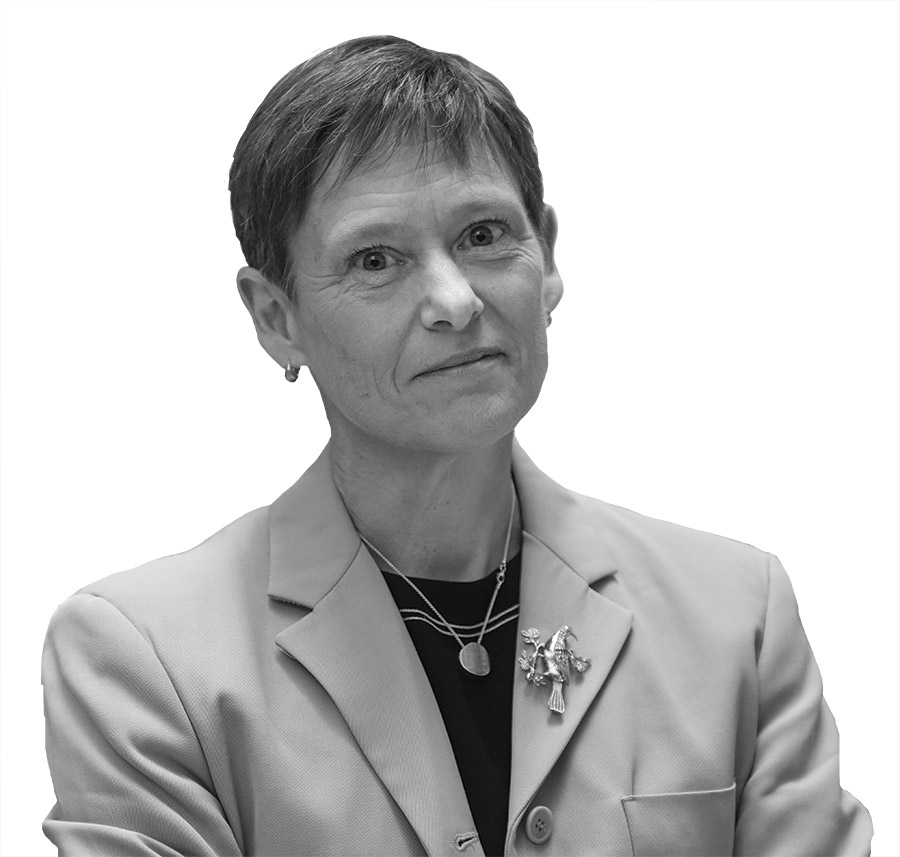
“Navigating the labor
market comes with its own set of challenges,
including securing specialized talent. ”
Fiona Cousins, Americas Chair, Arup
Platz says the integration of artificial intelligence is having a remarkable impact on everyone involved in project teams.
“AI has the potential to not only improve the efficiency of our teams and the quality of our projects but also help address staff shortages,” he points out. “By delegating tasks to AI, from communication to the design process, its tools offer both promise and risk, and as such they must be managed by licensed professionals to ensure the quality of the work performed.”
AO Managing Partner RC Alley says the No. 210- ranked firm has been actively experimenting with ways to integrate artificial intelligence into its practice as it begins to take off in the AEC sector.
“We firmly believe that AI is not just a passing trend but a permanent fixture in our industry,” he says. “We have found that AI serves as a powerful tool for design ideation and research. During the conceptual phase, it enables our designers to explore multiple alternatives and visualize possibilities, significantly augmenting our creative vision.”
Additionally, Alley points out that the company has leveraged artificial intelligence tools for zoning and research validation, enabling it to quickly explore alternative paths that have marginal impacts on employee workload.
“While we embrace benefits that AI brings to our practice, we remain grounded in the understanding that these can never fully replace our accumulated real-world expertise,” he says. “Our commitment to blending cutting-edge technology with human insight ensures we deliver the best possible outcomes for clients and communities.”
Black & Veatch, ranked No. 14, says it is also developing a digital strategy to leverage the full potential of AI, value creation, innovation and sustainable growth.
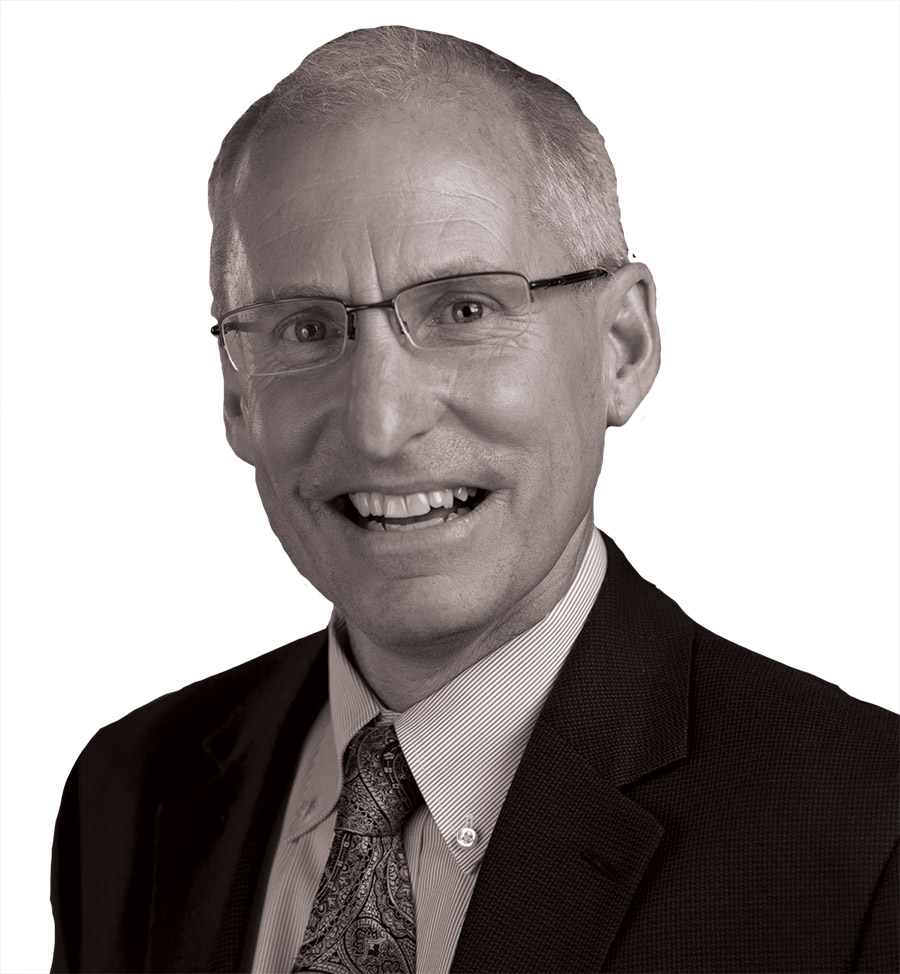
“AI has the potential to not only improve the efficiency of our teams and the quality of our projects but also help address staff shortages.”
Andy Platz, CEO and Chair, Mead & Hunt
“This initiative is providing us with the framework and capability for successful AI adoption, requiring careful planning, investment and commitment to ethical and responsible usage” of the technology, says Shibu Cherian, the company’s interim chief information officer. MG2 CEO and Chairman Smith summed up the proliferation of AI use among design firms as “exciting,” but says the technology is “daunting to comprehend.”
“The prospects for AI transforming how we produce our work are high, but the technologies are still developing,” says Smith. “We are actively exploring multiple platforms to evaluate how they might bring efficiencies to the practice, but at the same time we are implementing protocols to protect the security of our system.”
Like the industry’s adoption of Revit and BIM technologies, AI is primed to transform the design process in an even faster time frame, explains HMC Architects President and CEO Brian Staton.
“Going into the future, technology is going to continue to change this profession with BIM and artificial intelligence,” he says. “We are going to shift from drawings to solutions with thought-leadership being front and center. It will be about being innovative and solutions driven. No more drawings.”
Tech Integration
Beyond AI, Top 500 firms say they are exploring full digital integration at their companies to improve efficiency and reduce labor waste.
Arup is close to achieving “true digital and physical integration” with the help of digital twins employing AI algorithms, explains Gideon D’Arcangelo, Americas digital services portfolio leader.
“Digital twins are emerging as one part of the puzzle in achieving sustainable outcomes for buildings,” he says. “A digital twin can enable ‘what-if’ scenario planning and use feedback loops to look for ways to optimize energy use, saving owners and operators money and offering benefits for the planet.”
According to D’Arcangelo, “The more we connect our digital capabilities to sustainable outcomes, the more we will progress toward our collective goals as an industry.”
At GZA, President and CEO Patrick Sheehan says a mix of virtual reality, digital twins and telemetry is helping the firm deliver near real-time information and decision-making to clients.
“We are also seeing the benefits of augmenting these technologies with other tools such as machine learning,” he contends. “Additionally, our use of drones to capture image and LiDAR data is significantly improving service delivery to our clients, improving both response time and accuracy of deliverables.”
According to Thomas McCarthy, CEO of No. 41-ranked design firm Page, digital whiteboarding has amplified the design firm’s collaboration capabilities internally and with extended project teams. “It pulls people together quickly, regardless of their location,” he says.
Mixed reality and digital engineering take that process one step further at GHD. President Kumar Parakala says the technology enables the firm to harness the best of virtual and physical domains.

“While we embrace AI, we remain grounded in the understanding that it can never fully replace our real-world expertise.”
RC Alley, Managing Partner, AO
“It allows users to create an integrated and immersive virtual environment where real and digital elements coexist and enable a common ground for all stakeholders,” says Parakala, explaining that company employees leverage the technology as a way to support multidisciplinary team collaboration. “Liberated from geographical barriers, projects are visualized in a visually rich, interactive space that allows technical and non-technical users and audiences to better understand project complexities—and this is only one of many possibilities.”
Technology integration adds to a firm’s flexibility, says HMC Architects Chief Technology Officer Bill Kwon. “As we have all experienced during and post-pandemic, being digitally nimble in collaboration has made us even more effective in sharing ideas, collective design activity, and faster validation,” he says. “Virtual reality remains a more niche channel. Digital twins remain an important aspect in asset operational efficiency, but the true promise is how a fully sensored building opens great potential to enhance interactive and [experiential] design.”
Kwon adds that “the rise of AI is rapidly impacting both how we design and deliver drawings and models. The capabilities continue to outpace expectations and rate of change.”
According to Scott Crawford, principal and landscape architect at RDG Planning and Design, the use of AI and more digital tools are advancing design to be a fully visual process.
“At RDG design is a very creative and visual process, and the faster we make it immersive, the easier it is to generate consensus on ideas and alignment around inspired design,” Crawford says.
“We now utilize AI to instantaneously process design constraints and parametric requirements into millions of potential options, sorted through optimization routines and a decision hierarchy to arrive at tens of workable solutions. This allows our team to quickly curate viable solutions as a baseline for exploration—saving hundreds of hours in design.”
Urban Planning | By Jonathan Keller
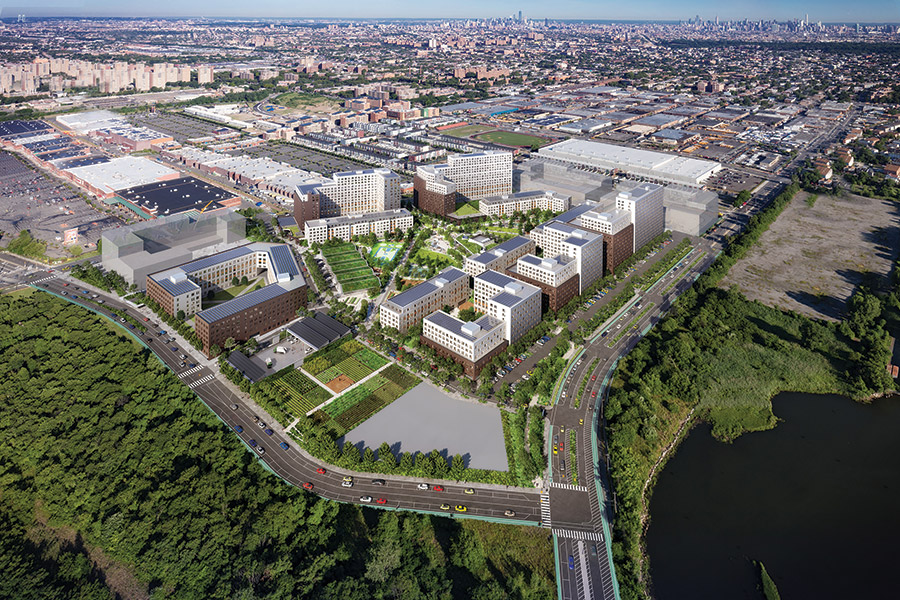
Rendering courtesy of Dattner Architects
Dattner Architects (No. 451) developed the master plan for Alafia, a wellness-oriented resilient development in the East New York neighborhood of Brooklyn, N.Y. It will provide more than 2,400 units of affordable housing, including for seniors. Located on a 28-acre decommissioned public site, the project is part of New York State’s $1.4-billion Vital Brooklyn initiative and is designed to be contained in a 15-minute walking radius. All residential buildings are designed to be Passive House certified. The site will have its own microgrid and added energy generation from rooftop solar arrays. Phase 1A of construction, including 452 housing units, is underway.
Design Hot Spots
Related to market health for design firms, the American Institute of Architects/Deltek Architecture Billings Index, released in February, reached 49.5. It’s below its targeted 50 score, but a modest increase after months of decline that began in July 2023.
“There are indicators this month that business conditions at firms may finally begin to pick up in the coming months,” said AIA Chief Economist Kermit Baker in a statement on the latest index. “Inquiries into new projects grew at their fastest pace since November, and the value of newly signed design contracts increased at their fastest pace since last summer.”
He added, “Given the moderation of inflation for construction costs and prospects for lower interest rates in the coming months, there are positive signs.”
Median revenue for Top 500 firms self-identifying as architects increased 14.2% to $58.4 million in 2023, from $51.1 million in 2022. Median revenue for architects is up 20.9% since 2019.
All main design markets that ENR tracks increased revenue between 2022 and 2023 except for oil and gas, which fell 6.7% after a slight resurgence last year. The manufacturing market, boosted by federal funding, experienced the largest growth, up 40.9% to $4 billion this year, representing a full sector recovery since it fell 55% between 2019 and 2020.
The power and industrial process markets, both up 23%, and water supply, up 20.7%, are other notable ascents. Those three markets have also seen the most growth since 2019—with power up 71.8% since that last pre-pandemic reading, industrial process rising 71.7% and water supply climbing 53%.
Skyscrapers | By Jonathan Keller
Dubai Tower Has Tallest Ceramic Facade
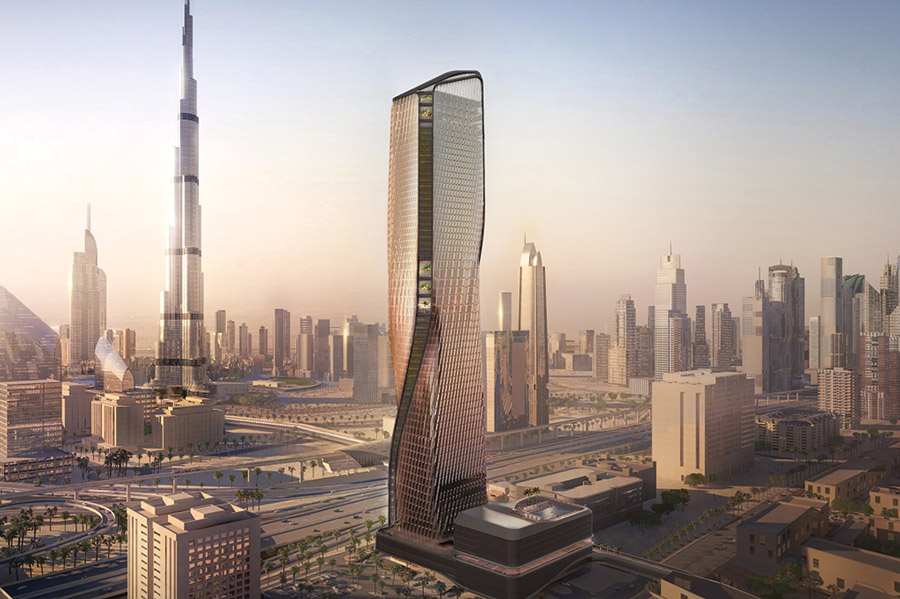
Rendering by UNStudio; courtesy of Desimone Consulting Engineers
DeSimone Consulting Engineers (No. 241) provided engineering services on the 64-story Al Wasl Tower in Dubai. Designed by UNStudio in collaboration with Werner Sobek, the skyscraper will have the world’s tallest ceramic facade, DeSimone says.
The facade’s overlay of interlaced, angled fin-shaped tiles will regulate the building’s internal temperature and provide shade from the sun, while reflecting sunlight into the interior. The system will also help mitigate ambient external noise. The facade’s lighting system, designed by Arup, is located behind the fins and is powered by PV panels at the car park building below.
The 1.86-million-sq-ft tower boasts a range of renewable solutions for energy efficiency, such as solar thermal panels for hot water and bronze-coated reflective glazing to enhance thermal performance.
Construction is expected to be completed in the third quarter.
A Transition Period
Leading water and industrial engineer Kennedy Jenks says it is experiencing the same market pressures as its clients, “such as inflation on the cost of doing business and running our projects,” says President and CEO Keith London. “Supply chain pressures have eased considerably in the last year, but pressures from inflation remain.”
Amid increasingly complex challenges, the AEC sector finds itself in a period of transition, say Top 500 firm executives.
At Orbital Engineering, that transition is reflected in a reconfiguring of its leadership style. “We continue to drive accountability and responsibility to lower level leaders so better decisions can be made at earlier stages,” says Dylan Lewis, president and chief legal counsel. “To the extent individuals down the ladder don’t have that decision-making authority, they are least understanding of business reasons behind the issues, so information flows up to the appropriate decision-makers more quickly and in a concise manner.”
RDG’s Crawford says the transition of workers, leadership and technology are challenges “shared by the industry overall.” Yet what sets firms apart is their willingness to embrace innovative solutions.
“We’ve been aware these issues were on the near horizon in recent years and have been making preparations to ensure our success,” says Crawford. “They are now fully upon us and … the challenges will be fully met in 2024. That said, we are successfully embracing them and are enthusiastic about the future we’re forging together.”
